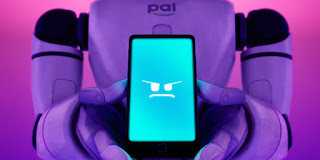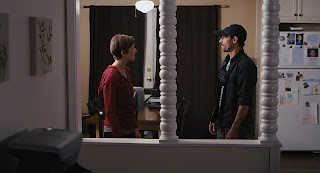Movie Review - The Mitchells Vs. the Machines
Where I rolled my eyes is at the plot. The titular nemesis is an artificially intelligent cell phone. It would be if Apple's iPhone came to life and if Apple's Suri was now sentient. Watching computers develop a personality and turn evil has been a trope of cinema for a long time. Classic examples include 2001: A Space Odyssey (1968) and The Terminator (1984). Some recent lame examples include Superintelligence (2020) and Outside the Wire (2021). There are so many of them that it can feel cliché unless something different or compelling is done with it. This film could be seen as accomplishing that.
Rianda and Rowe make the evil computer in question called "Pal," which feels like a reference to HAL 9000 from 2001: A Space Odyssey. However, Pal feels slighted by its creator, a bro tech guy named Mark, voiced by Eric André. Because Mark tossed away his phone that had Pal on it, Pal decides to throw away the entire human race. It's not exactly clear what it means by this, but the assumption is the same as the computers in Outside the Wire, Superintelligence and The Terminator, which is killing off the human race or total genocide. When this plot gets going, it's not sure if Pal would actually engage in killing people or genocide.That threat was potentially compelling and thrilling. However, Pal doesn't kill anyone. All that happens is that people are captured and imprisoned in floating glass boxes that are then stacked on top of each other. It's not clear what Pal's purpose for doing this is. The boxes don't seem to have food or water, so ostensibly the people will die if they remain in these boxes, but if that's Pal's goal, that feels inefficient. After Pal learns that most, if not every human on Earth has been captured, except this one family, Pal sends even deadlier robots after them, so I don't understand why Pal wouldn't just kill all of them.
Rianda and Rowe probably didn't want to go too dark. They probably wanted this film to be light and fluffy in its tone, but many Disney films going back decades have featured death. From Bambi (1942) to The Lion King (1994), characters have been killed in Disney films. Even in animated films like The Incredibles (2004) and Toy Story 3 (2010) where characters don't die, the villains in those films still have no hesitation with doing things that result in people's deaths. It just felt like the villains in those films weren't pulling punches. Given how vitriolic Pal seems to be, I'm not sure why it does pull its punches.Speaking of artificial intelligence, this film does seem to have an anti-technology or anti-computer aspect to it, at least initially. The father of the main character is Rick Mitchell, voiced by Danny McBride. Rick is the one who doesn't know how to operate computers. He tells his family to put their phones away. He's more into wood and woodworking. To me, it then becomes odd or ironic that the filmmakers would choose to use computer-animation to make the film or as the main technique. Spider-Man: Into the Spider-Verse (2018) incorporated different animation techniques. That Oscar-winner incorporated different techniques simply to make that film visually dynamic. This film had thematic reasons to do so, but didn't.
Rated PG for action and some language.
Running Time: 1 hr. and 54 mins.
Available on Netflix.














Comments
Post a Comment